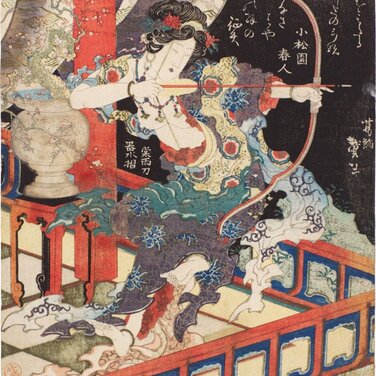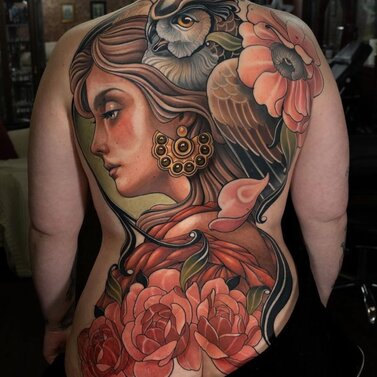Article
Breaking Down Neo-Traditional Tattoos
Neo-Traditional describes a subset of contemporary tattoos that blend the aesthetic base of Western traditional tattoos with a tighter intersection with art historical reference points. Generally, Neo-traditional tattoos focus on figurative elements such as portraits or animals. Neo-Traditional tattoo artists include Fiori Lorett, Krish Trece, Giorgia Mae Rawlings
October 10, 2024

Neo-Traditional describes a subset of contemporary tattoos that blend the aesthetic base of Western traditional tattoos with a tighter intersection with art historical reference points. Generally, Neo-traditional tattoos focus on figurative elements — portraits or animals, for instance. The central element is often adorned with motifs drawn from art nouveau or art deco, repositioning 19th and 20th century inspiration to give the tattoos a more studied, dimensional composition than in strict traditional tattooing.
The CO:CREATE Method
Every tattoo style has a range of expressions. At CO:CREATE, we acknowledged that range, and are focused on three core considerations for describing the tattoo you want: aesthetic, iconography, and technique.
Aesthetic refers to how the tattoo looks. Line weight, color, saturation, movement with the body all contribute to look.
Iconography examines the meaning attached to the tattoo. We describe the cultural, historical, and spiritual connections chosen imagery carries and communicates.
Technique specifies the methods used to. For example, different techniques of shading (whip, dot, drag, etc.) create different levels of depth and dimension. Color layering, color packing, or distinct forms of linework, all contribute to refining the final form of your tattoo.
Discussing these three elements with your artist helps assure you get your dream tattoo.
Neo-Traditional Iconographic Sources
What's most fascinating about the Neo-traditional style is that the source material comes from investigation of the art movements of the Victorian and Edwardian eras, and slightly beyond; roughly speaking 1870-1930. The style pulls from the period's fascination with Japanese folklore and art, a symptom of Japan's opening to western trade in 1853, and the impact of this influence on European art and design movements. The sumptuous color and motifs of art nouveau and the angularity of art deco are both key sources. Commonality in the two art movements comes in the embrace of stylized geometries and stylized organic forms. Both contribute to creating dynamic surround for central iconography: female figures and animals.
Neo-Traditional Aesthetics
Positioning the figurative against lush, dimensional backdrops is key to the Neo-traditional aesthetic. Tattoos in the style are softer and denser than traditional tattoos. The floral, geometric, and even lace-like adornment, are in opposition to the flat structure of traditional tattoos. The colors are dramatic, far more varied than the traditional palette, and contributed to the lushness of the designs.
Neo-Traditional Techniques
Despite an aesthetic that is at times in opposition to the traditional tattoo style, Neo-traditional follows the core technical rules of its forbearer. Lines, whether bold or thin, clearly outline the elements of the tattoo. Color is held within those black borders, which keep clear, sharp separation between components of the design. Color blending takes precedence over other shading techniques. There is, on the whole, less color packing than in the traditional style.
Neo-Traditional History
The neo-traditional style has developed and matured over the past quarter century. It emerged out of new school tattooing, which merged graphic sensibilities from, among other elements, graffiti and traditional tattooing. The subjects were cartoony, hyper contemporary, and the colors bold and bountiful, though the technical rules still honored clear black outlines. The return to favor of traditional tattoo style in the 2000s opened up space to explore a counter that was not so overtly different aesthetically, but brought a more studied, art school approach to combining late 19th century high art and design culture. The result is remarkable, with the neo-traditional style honoring a technical foundation and seamlessly advancing it through incorporation of tightly focused aesthetics and motifs.
Neo-Traditional Artists
CO:CREATE Artists Fiori Lorett, Krish Trece, Bence Kormos and Giorgia Mae Rawlings exemplify the neo-traditional style. Explore these artists and many more of the world's best tattoo artists on CO:CREATE.
Discover
Artists
Connect
© 2025 Gesso Labs, Inc.
Privacy PolicyTerms of ServiceReferral TermsGiveaway RulesArtist AddendumAI & LLM




























